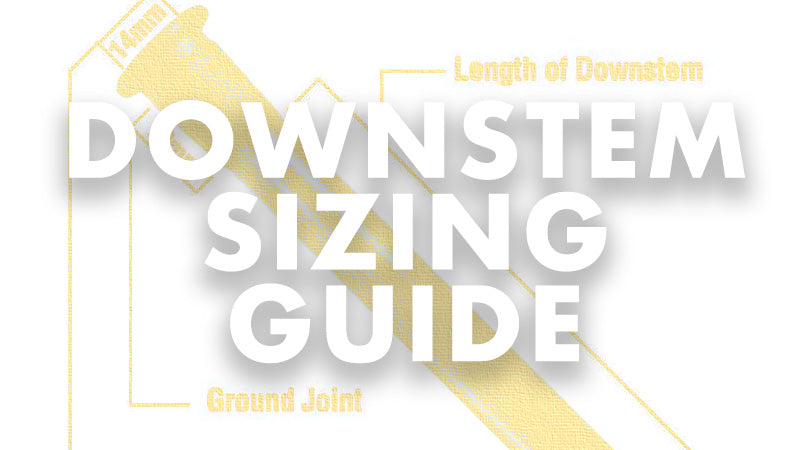Finding The Right Downstem
A downstem has a thankless job, so many stoners don't even know what it is and yet it is the piece that keeps them from inhaling super harsh hits full of contaminants. There may come a time, however, when you need to replace your downstem, and at this point, you'll need to know what it is and how to measure it. This guide will help you with you exactly that, making replacing your downstem a very easy process.
What Is a Downstem
A downstem is a part of a bong that forces your smoke through the water chamber to cool and filter your hits. It does this through the creation of intense suction pressure (from you inhaling) that pulls all the smoke from your bowl down into the chamber. It is essentially a connector piece with the bowl on one side and the water chamber on the other; It features a long cylindrical shape that is made from glass. Downstems are sometimes also referred to as downpipes, adapters, tubes, or stems.
Downstems can be fixed, meaning that are not a separable piece from the bong, or they can be detachable. It is also possible that some bongs don't have a downstem, but this is very unusual and not advised. If you have a bong with a detachable downstem then you can replace your downstem if it breaks, otherwise, if you have a fixed downstem and it breaks you will need a whole new bong.
Measuring a Downstem
Measuring a downstem isn't the simplest process, yet it's important to get the size right to make sure it fits into your bong perfectly. There are two measurements that are important in sizing a downstem: the length of the downstem and the size of the joint. Remember though, you can always just grab a invincipole downstem, so you don't have to worry about length!

Measuring Downstem length
To measure your downstem length, lay the piece flat on the ground and measure with a ruler from the top edge of the lower joint all the way to the end. For reference, this length will typically be around 4 or 5 inches, so if you are way off you may want to remeasure.
If you need to replace your downstem but don't still have your old downstem or are unable to measure it don't worry, you can still accurately figure out the right sized downstem to go get. To do this, take a pencil (or any similarly shaped object) and stick it into the bong where your downstem normally goes. Then, take a pen and mark the closest part of the pencil that you can. After this, take your pencil out and measure from your marked spot to the end of the pencil that was in your bong. Finally, subtract half an inch and then you have an accurate measurement of how large a downstem you need.
Measuring downstem joint size
Measuring the joint size is also necessary for determining which replacement downstems will work in your bong. Without the right joint size, you won't be able to fit your downstem in with an airtight seal, and this will prevent the suction that ultimately pulls your smoke through the water chamber. To measure the joint size, take your ruler and measure across the top of it. The two most common joint sizes are 14.5 millimeters and 18.8 millimeters. It is more than likely that your joint will be one of these sizes but it's still necessary to measure carefully because there are technically other sizes, even if they're rare.
Measure bong joint size without a ruler
If you're ever in a pinch for whatever reason and don't have access to a ruler there are still other ways to measure the joint size. One way to do this is to take a penny and put it on top of the joint socket, if it fits close to perfect then your joint size is 18.8 millimeters. If your joint size is relatively smaller than the penny then you likely have a 14.5-millimeter joint size. This isn't full proof since there are other larger and smaller sizes than these two but it's the best you can do without a ruler and it's pretty accurate.
Another thing to consider is that even if you don't have a wooden physical ruler is that you may still be able to use a virtual version of one. One way to do this is by printing out a ruler, you can image search a standard ruler and then print it onto a regular white sheet of paper. Another way to do this is to use measuring apps, some phones even come preloaded with their own measuring applications.
Types of Downstems
Other than sizing your downstem correctly, it's also important to know what type of downstem you need, yes there are a few different types.
Downstem With or Without Bowls
As mentioned briefly earlier, some downstems are fixed with a bowl and cannot be separated while some are separate pieces. The downstems that are inseparable from their bowls are cheaper but also more elementary, they don't allow you to switch out your bowls (in case you want to increase its size or get a bowl with a handle) and you also need a whole new bong when they break.
Downstem with Two Grinding/Joints/Sockets
Most downstems have two joints, one of them that is well inside the bong and one of them that is sticking outwards. The good thing about these types of downstems is that you can have the joint on the inside be the smaller sized 14.5 millimeters and the outer one the larger 18.8 millimeters. This will allow you to have both sized joints in case you ever want to utilize your downstem with a larger bowl.
Inside Cut Downstem
An inside cut downstem is the opposite of what was just mentioned, it only has one noticeable joint (it has a second joint cut inside of the first joint). Because of this, it has a much sleeker and cleaner look than two jointed downstems but doesn't offer the same versatility; your downstem will appear as if your bowl connects directly to your bong without a downstem.
Bottomline
Whether you dropped your bong and the downstem broke or you are replacing your bowl you will need to accurately measure what kind of replacement downstem to get. This is a simple process but it's important to remember you are measuring for length and joint size. Aside from knowing how to measure a downstem, it's a good idea to know the different types of downstems to determine what would work best for you. Downstems are an extremely necessary part of your bong, so it's a good idea to understand everything you learned from reading this blog including how to measure it, what they do, and what types there are.






